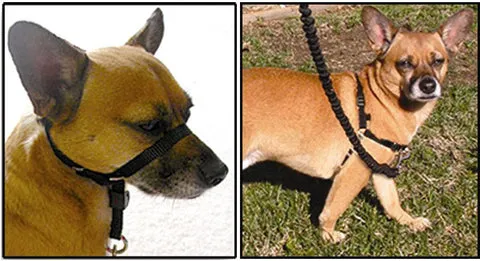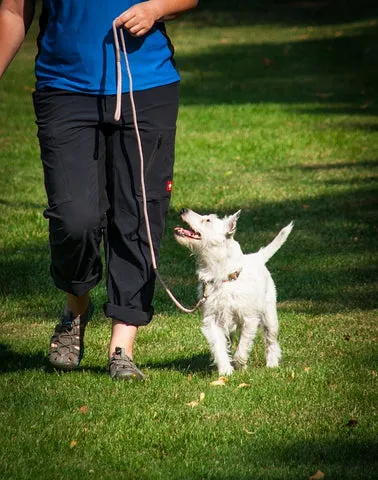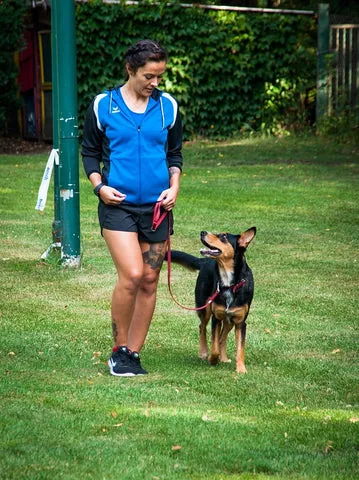Walking your dog should be a joyful experience for both of you, but a dog that constantly pulls on the leash can turn a pleasant stroll into a frustrating struggle. Many dog owners dream of their canine companion walking calmly by their side, stopping when they stop, turning when they turn, and ignoring distractions like other dogs and people. Teaching your dog proper leash manners, including how to walk without pulling, is one of the most rewarding training challenges you can undertake, setting the foundation for enjoyable outings for years to come. This comprehensive guide will equip you with the techniques to make that vision a reality, transforming your dog into a polite walking partner. You’ll learn effective strategies to encourage loose-leash walking and understand the nuances of canine behavior to foster a stronger bond during your daily adventures. For other common puppy challenges, consider exploring resources on topics like why a puppy breaks out of crate.
Preparing for Loose-Leash Training
Before diving into formal loose-leash training, it’s beneficial to consider the right equipment. While a head collar or a front-attachment harness can be invaluable tools to help manage pulling, they are not a substitute for proper training. These devices merely discourage pulling by redirecting your dog’s momentum or head. For long-term success in teaching your dog to walk without pulling, consistent training is key.
A front-attachment harness is often recommended as a safe and easy-to-use no-pull device suitable for most dogs. It works by attaching the leash to a ring on your dog’s chest, which turns them around when they pull, preventing them from forging ahead. For dogs with strong pulling tendencies or those that require maximum control, such as a large breed with a smaller owner, a head collar for dogs can be particularly effective. It offers more direct control over your dog’s head, which naturally influences their body.
 A small tan dog wears a head collar on the left and a front-attachment harness on the right
A small tan dog wears a head collar on the left and a front-attachment harness on the right
It is crucial to use front-attachment harnesses and head collars with a leash that is no longer than 6 feet. Using an excessively long leash can allow your dog to gain too much speed, potentially causing injury if they abruptly hit the end of the leash while pulling.
The Stop and Reward Method
A fundamental technique for How To Train A Dog To Walk Without Pulling is the “stop and reward” method. This involves stopping your forward movement the moment your dog begins to pull on the leash. The instant the leash slackens, and your dog looks back at you or returns to your side, you reward them with praise and a treat. Using a treat bag worn at your waist can make this process much more efficient, allowing for quick and timely rewards.
If your dog isn’t highly motivated by food treats, consider using a favorite tug toy, chew toy, or even tossing a ball as an alternative reward. The key is to find something your dog values highly to make the training experience positive and reinforce the desired behavior. Consistency is vital; every time your dog pulls, you stop. This teaches them that pulling gets them nowhere, while a loose leash leads to progress and rewards.
Step-by-Step Loose-Leash Training
Here’s a detailed, step-by-step approach to teaching your dog to walk politely on a leash, focusing on how to train a dog to walk without pulling.
Step 1: Making Walking Beside You a Delicious Experience
Start your loose-leash training in a familiar, low-distraction environment, such as your backyard. Equip your puppy or dog with a standard harness and a long rope or leash (10-20 feet long, not retractable). Prepare a generous supply of highly palatable, pea-sized treats, like fresh meat or cheese.
Decide which side you prefer your dog to walk on (the left is traditional). This will be your designated “reward zone.” As you walk briskly and randomly around your yard, every time your dog chooses to walk close by your preferred side, praise them and immediately deliver a treat directly to your thigh on that side. The goal is for your dog to associate being in that position with delicious rewards, naturally encouraging them to stay there. Initially, reward every few steps they walk politely beside you. As they improve, you can gradually reduce the frequency of rewards. If your dog seems uninterested, try training when they are a bit hungrier.
Step 2: Encouraging Your Dog to Follow Your Lead
This step teaches your dog to pay attention to your movement. While walking in your yard, wait for a moment when your dog drifts away, lags behind to sniff, or attempts to potty. In an upbeat voice, say “Let’s go!” and immediately turn and walk in the opposite direction. You can lightly slap your thigh to get their attention in the beginning.
The instant your dog catches up to you, praise them enthusiastically and reward them with a treat near your preferred side. Continue to reward them every few steps if they maintain their position. If they respond quickly, give an extra special reward.
If the leash tightens and your dog doesn’t respond to “Let’s go,” stop walking and apply gentle, consistent pressure on the leash. This pressure is a reminder, not a force. The moment they start moving towards you, release the pressure and praise them. When they reach your side, reward them as before. Continue this practice until your dog consistently returns to your side when you say “Let’s go,” even if they’ve veered off. This teaches them that your movement dictates the walk.
Step 3: Scheduled Sniffing and Potty Breaks
While teaching your dog how to train a dog to walk without pulling, it’s important to allow them opportunities to explore and relieve themselves. However, you should initiate these breaks to establish better manners. Roughly every five minutes during your training session, at a time you would typically give a food reward, say something like “Go sniff” and allow your dog a designated period to explore their surroundings or go potty on the leash.
Consider this “free time” a privilege or reward. If your dog pulls excessively during this period, immediately say “Let’s go” and change direction, effectively ending the sniff break. When you’re ready to resume polite walking, simply say “Let’s go” and continue your walk. This teaches your dog that appropriate sniffing and pottying are on your terms, making them more attentive during structured walking segments.
Step 4: Mastering Challenges and Reducing Rewards
As your dog becomes more proficient in the previous steps, gradually reduce the length of your training leash to a standard 6-foot leash. Continue practicing the techniques in your yard. Introduce new challenges: practice walking extra fast, extra slow, and making sudden stops or changes in direction. Reward your dog generously if they manage to stay by your side through these varied paces and movements.
Over time, you can begin to reward your dog less frequently for simply walking by your side under normal circumstances. However, maintain a high reward rate when you introduce new challenges, such as unexpected stops, rapid changes in pace or direction, or when encountering distractions like another animal or person. This reinforces their focus during difficult situations, solidifying their understanding of how to train a dog to walk without pulling.
 White dog on leash watching owner
White dog on leash watching owner
Taking Your Training to the Street
Once your dog has mastered loose-leash walking in your yard, it’s time to transition these skills to the more distracting environment of your neighborhood. The principles remain the same, but the presence of friendly strangers, squirrels, and other dogs will present new challenges. For enhanced control in these situations, consider using a front-attachment harness or head collar, and be sure to bring your dog’s most appealing treats, such as fresh meat or cheese.
Begin your walks by saying “Let’s go” and starting to move. If your dog gets distracted or starts to pull, immediately say “Let’s go” and turn to walk in the opposite direction. Reward them generously with treats when they walk calmly beside you. It’s especially important to provide extra rewards when they manage to stay focused and walk politely despite significant distractions. Remember to also grant permission for sniff breaks as learned in Step 3. Managing your dog’s interactions with other canines is also vital; understanding dog dominance behavior with other dogs can help you navigate these encounters more smoothly.
 Woman walking attentive black and tan dog
Woman walking attentive black and tan dog
Challenging Your Dog with Distractions
To further solidify your dog’s ability to walk without pulling, introduce controlled distractions. With your dog in a standard harness and a 6-foot leash, toss a favorite ball or treat about 20 feet away.
If your dog immediately lunges towards the object, say “Let’s go” and turn and walk in the opposite direction. This teaches them that pulling won’t get them what they want. If, however, they maintain a loose leash and walk calmly beside you towards the object, allow them to reach it and claim it as their reward. Initially, you might find it easier to use a longer leash or a less desirable object to set your dog up for success. This method reinforces that staying with you is the quickest way to get to desirable rewards.
Troubleshooting Common Leash Issues
Even with consistent training, you might encounter some common challenges:
- Dog Crossing in Front of You: If your dog frequently crosses your path, try shuffling or stomping your feet slightly to make your presence more obvious and encourage them to stay beside you.
- Lagging Behind Significantly: A dog lagging behind might be frightened or not feeling well. In these cases, offer plenty of verbal encouragement rather than pulling them along. If they’re lagging to sniff or potty, simply continue walking with gentle leash pressure, and remember to reward them generously when they do catch up and walk with you. Sometimes, a dog might also exhibit behaviors like constantly chewing her paws which can be a sign of anxiety that impacts their willingness to walk.
- Alternating Between Pulling and Walking Politely: If your dog seems to be in a cycle of pulling then coming back, stop rewarding the act of returning after a pull. Instead, focus your rewards on consecutive steps taken by your side without pulling. This shifts their focus from correcting a pull to proactively maintaining a loose leash. For other persistent behavioral issues, understanding conditions like compulsive licking disorder in dogs can provide insights into underlying stressors.
 Small white and brown dog on a leash in the snow
Small white and brown dog on a leash in the snow
Teaching Your Dog to Heel
Heel training is a specific form of loose-leash walking where your dog walks precisely by your side, highly attentive to your movements. This command is incredibly useful for short durations when you need your dog to be very close and focused, especially when passing significant distractions. This is a higher level of precision compared to general loose-leash walking.
Start practicing “heel” in a quiet area of your home. Hold a treat in your closed fist and let your dog sniff it. Say “Heel” or “Let’s go” (depending on your chosen command) and take a couple of steps, guiding your dog along with the treat in your fist near your thigh. Praise and reward them with the treat the moment they are following your fist with their nose and staying in position.
Next, practice having your dog follow your empty fist. Continue to praise and reward them for every few steps they follow your hand signal. Gradually increase the number of steps and the duration of the heel position, raising your standards with each session. Your closed fist will serve as a visual hand signal for the “heel” command. Once proficient indoors, progressively move to more distracting environments outdoors. It’s also important to address other behavioral issues that might impact focus, such as learning how to stop dog barking in crate at night, which can improve overall obedience.
Conclusion
Mastering how to train a dog to walk without pulling requires patience, consistency, and positive reinforcement, but the effort is immensely rewarding. By implementing these step-by-step techniques—from using appropriate equipment to encouraging your dog to follow your lead, scheduling breaks, and managing distractions—you can transform your dog into a polite and enjoyable walking companion. Remember that every dog learns at their own pace, so celebrate small victories and maintain a positive attitude. With dedication, you and your furry friend will soon be enjoying peaceful walks together, strengthening your bond and making every outing a pleasure.
